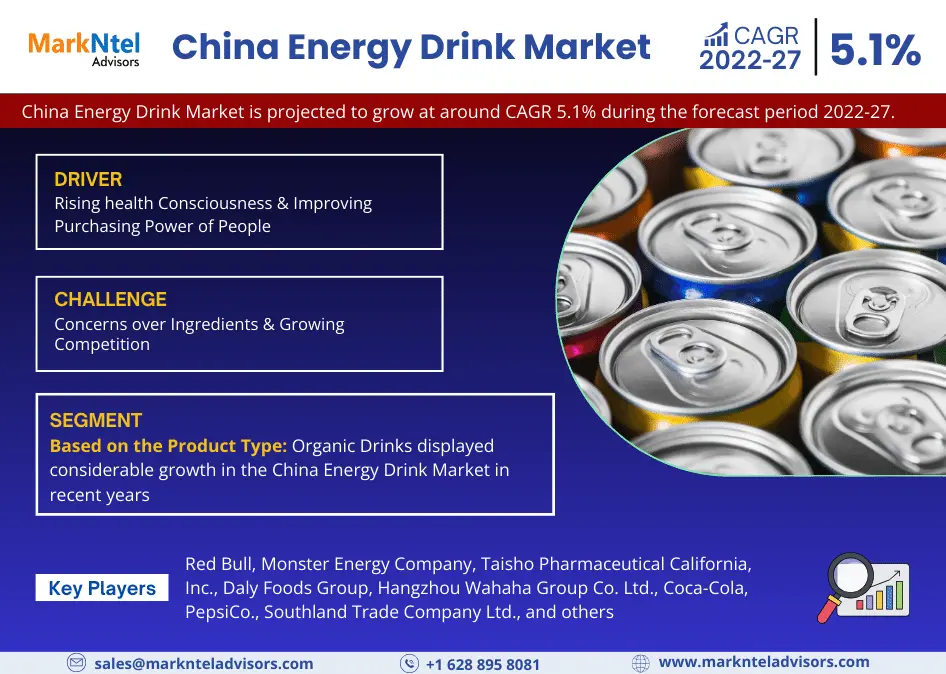
China Energy Drink Market Research Report: Forecast (2022-27)
By Product Type (Organic, Non-Organic, Natural), By Product (Alcoholic, Non-Alcoholic), By Target Customer (Teenagers, Adults, Geriatric), By Distribution Channel (Off-Trade, On- T...rade), By Region ((North East (Beijing, Hebei, Heilongjiang, Jinlin, Liaoning, Shandong, Tianjin), North Central (Nei Mongol AR (Inner Mongolia), Shanxi), North West (Gansu, Ningxia Hui AR, Shaanxi, Qinghai, Xinjiang Uyghur AR)), South West (Chongqing, Guangxi AR, Guizhou, Sichuan, Xizang AR (Tibet), Yunnan)), South Central (Anhui, Henan, Hubei, Hunan, Jianxi)), South East (Fujian, Guangdong, Hainan, Jiangsu, Shanghai, Zhejiang)), By Competitors (Red Bull, Monster Energy Company, Taisho Pharmaceutical California, Inc., Daly Foods Group, Hangzhou Wahaha Group Co. Ltd., Coca-Cola, PepsiCo., Southland Trade Company Ltd., Otsuka Pharmaceutical etc.) Read more
- Food & Beverages
- Mar 2022
- Pages 132
- Report Format: PDF, Excel, PPT
Market Definition
Energy drinks are carbonated or non-carbonated drinks that contain a high percentage of sugar, caffeine, or other stimulants to provide a soothing effect upon consumption. With the growing health consciousness & improving purchasing power of people, the demand for energy drinks is escalating across China, and gaining swift popularity, especially among the younger population.
Market Insights
The China Energy Drink Market is projected to grow at around CAGR 5.1% during the forecast period, i.e., 2022-27. The growth of the market is driven primarily by the active participation of several energy drink manufacturers & their growing focus on developing new marketing strategies like alignment with popular sports events, etc., to increase awareness about energy drinks and boost their sales across China.
| Report Coverage | Details |
|---|---|
| Study Period | Historical Data: 2017-20 |
| Base Year: 2021 | |
| Forecast Period: 2022-27 | |
| CAGR (2022-2027) | 5.1% |
| Key Companies Profiled | Red Bull, Monster Energy Company, Taisho Pharmaceutical California, Inc., Daly Foods Group, Hangzhou Wahaha Group Co. Ltd., Coca-Cola, PepsiCo., Southland Trade Company Ltd., Otsuka Pharmaceutical etc |
| Unit Denominations | USD Million/Billion |
Besides, with the growing collaboration among beverage manufacturers & escalating number of strategies to increase awareness & adoption of energy drinks in China, the demand for these drinks is likely to witness a hike and positively influence the market growth over the forecast years.
Furthermore, the active participation of prominent players in introducing an extensive range of energy drinks to suit different requirements & tastes is widening the customer base, which is another crucial factor projected to stimulate the market growth in the coming years.
Impact of Covid-19 on the China Energy Drink Market
The advent of Covid-19 in 2020 had the worst effect in China, yet the China Energy Drink Market underwent a positive impact amidst the crisis. With the imposition of stringent movement restrictions & lockdown by the Chinese government to curb the spread of this dreadful disease, people had to remain at home, which, in turn, resulted in the shutdown of public places like sports arenas, gyms, etc.
However, since people continued their workout regimes at home, the demand for energy drinks remained consistent in the country amidst the pandemic. Slight difficulties in increasing the production capacities to meet the burgeoning requirement of energy drinks in China introduced a slowdown in the market growth. However, the overall demand rate displayed an upswing for the market.

Market Segmentation
Based on the Product Type:
- Organic
- Non-Organic
- Natural
Of them all, Organic Drinks displayed considerable growth in the China Energy Drink Market in recent years. It owes principally to the rapidly growing health consciousness among consumers & sports communities with the use of natural ingredients like guarana black tea, green tea, & green coffee beans.
Besides, the addition of natural extracts for reducing the usage of sugar content in Energy Drinks is another prominent factor soaring the demand for Organic Energy Drinks across China and fueling the overall market growth.
On the other hand, Non-Organic drinks dominated the China Energy Drink Market in recent years, and the same trend is likely during the forecast period. It attributes principally to the easy availability & longer shelf life of non-organic drinks that offer easy storage & transportation across the country.
Amongst all companies in the China Energy Drink Market, the leading player, Red Bull GmbH, an Austria-based multinational company, is actively operating in the beverages segment and launched its first product in 1987. In the energy drinks segment, the company offers five types of Red Bull Drinks, viz., Red Bull Summer Edition, Red Bull Purple, Red Bull Yellow Edition, Red Bull Sugar-free, & the Red Bull Original. In 2020, Thailand’s T.C. Pharmaceutical Industries Co. Ltd (TCP), the original inventor of 'Red Bull,' announced to invest USD150 million in China to expand its presence.
Recent Developments by Leading Companies
- In February 2021, Tonino Lamborghini signed a license with the Chinese company, New Awaken Ltd., to launch their first Sugar-Free Energy Drink.
- In May 2020, Genki Forest, a prominent beverage manufacturing company, launched a new energy drinks sub-brand with benefits like zero sugar, zero fat, refreshment, no artificial colors, no hormones, no weight gain, etc.
Market Dynamics:
Key Driver: Rising health Consciousness & Improving Purchasing Power of People
Growing awareness, availability, & affordability of Energy Drinks entwined with increasing disposable income is encouraging leading players to introduce a new & extensive range of Energy Drinks for consumers. It, in turn, would drive the China Energy Drink Market during 2022-27.
Growth Restraint: Concerns over Ingredients & Growing Competition
Escalating concerns associated with the high content of sugar & carbonated ingredients in energy drinks might restrain the growth of the China Energy Drink Market among the health-conscious population of the country. Moreover, increasing competition and availability of low-priced energy drinks are other crucial aspects that would challenge the expansion of the leading market players during the forecast period.
Key Questions Answered in the Market Research Report:
- What are the overall statistics or estimates (Overview, Size- By Value, Forecast Numbers, Segmentation, Shares) of the China Energy Drink Market?
- What are the region-wise industry size, growth drivers, and challenges?
- What are the key innovations, opportunities, current & future trends, and regulations in the China Energy Drink Market?
- Who are the key competitors, their key strengths & weaknesses, and how do they perform in the China Energy Drink Market based on the competitive benchmarking matrix?
- What are the key results derived from surveys conducted during the China Energy Drink Market study?
Frequently Asked Questions
- Introduction
- Research Process
- Assumption
- Market Segmentation
- Market Definition
- Executive Summary
- Impact of Covid-19
- China Energy Drinks Market Outlook (2017-2027)
- Market Size & Analysis
- By Revenues (USD Million) and Volume (Million Litres)
- Market Share & Analysis
- By Product Type
- Organic
- Non Organic
- Natural
- By Product
- Alcoholic
- Non Alcoholic
- By Target Customer
- Teenagers
- Adults
- Geriatric
- By Distribution Channel
- Off-Trade
- On- Trade
- By Region
- North East (Beijing, Hebei, Heilongjiang, Jinlin, Liaoning, Shandong, Tiangjin)
- North Central (Nei Mongol AR (Inner Mongolia), Shanxi)
- North West (Gansu, Ningxia Hui AR, Shaanxi, Qinghai, Xinjiang Uyghur AR)
- South West (Chongqing, Guangxi AR, Guizhou, Sichuan, Xizang AR (Tibet), Yunnan)
- South Central (Anhui, Henan, Hubei, Hunan, Jianxi)
- South East (Fujian, Guangdong, Hainan, Jiangsu, Shanghai, Zhejiang)
- By Company
- Revenue Shares
- Strategic Factorial Indexing
- Competitor Placement in Markntel Quadrant
- Market Attractiveness Index
- By Product Type
- By Product
- By Target Consumer
- By Distribution Channel
- By Region
- By Product Type
- Market Size & Analysis
- China Energy Drinks Market Policies, Regulations, Product Standards
- China Energy Drinks Market Trends & Insights
- China Energy Drinks Market Dynamics
- Growth Drivers
- Challenges
- Impact Analysis
- China Energy Drinks Market Hotspot and Opportunities
- China Energy Drinks Market Key Strategic Imperatives for Success and Growth
- China Energy Drinks Suppliers Margin and Value Chain Analysis
- China Energy Drinks, Key Consumer Preferences While selecting a Brand
- Competition Outlook
- Competition Matrix
- Product Portfolio
- Brand Specialization
- Target Markets
- Target End Users
- Research & Development
- Strategic Alliances
- Company Profiles
- Red Bull
- Monster Energy Company
- Taisho Pharmaceutical California, Inc.
- Daly Foods Group
- Hangzhou Wahaha Group Co. Ltd.
- Coca-Cola
- PepsiCo.
- Southland Trade Company Ltd.
- Otsuka Pharmaceutical etc
- Disclaimer
MarkNtel Advisors follows a robust and iterative research methodology designed to ensure maximum accuracy and minimize deviation in market estimates and forecasts. Our approach combines both bottom-up and top-down techniques to effectively segment and quantify various aspects of the market. A consistent feature across all our research reports is data triangulation, which examines the market from three distinct perspectives to validate findings. Key components of our research process include:
1. Scope & Research Design At the outset, MarkNtel Advisors define the research objectives and formulate pertinent questions. This phase involves determining the type of research—qualitative or quantitative—and designing a methodology that outlines data collection methods, target demographics, and analytical tools. They also establish timelines and budgets to ensure the research aligns with client goals.
2. Sample Selection and Data Collection In this stage, the firm identifies the target audience and determines the appropriate sample size to ensure representativeness. They employ various sampling methods, such as random or stratified sampling, based on the research objectives. Data collection is carried out using tools like surveys, interviews, and observations, ensuring the gathered data is reliable and relevant.
3. Data Analysis and Validation Once data is collected, MarkNtel Advisors undertake a rigorous analysis process. This includes cleaning the data to remove inconsistencies, employing statistical software for quantitative analysis, and thematic analysis for qualitative data. Validation steps are taken to ensure the accuracy and reliability of the findings, minimizing biases and errors.

4. Data Forecast and FinalizationThe final phase involves forecasting future market trends based on the analyzed data. MarkNtel Advisors utilize predictive modeling and time series analysis to anticipate market behaviors. The insights are then compiled into comprehensive reports, featuring visual aids like charts and graphs, and include strategic recommendations to inform client decision-making









